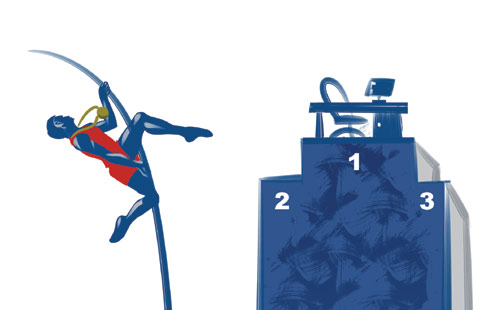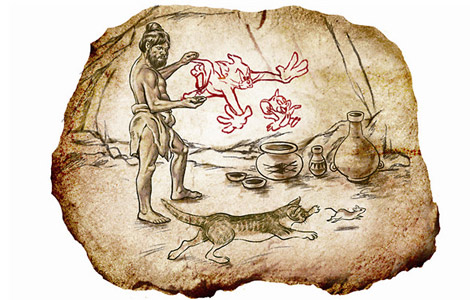Dance to the fading drumbeat
Updated: 2014-02-27 07:31
By Wang Kaihao (China Daily)
|
|||||||||||
Another centuries-old tradition is at risk of losing its luster. Wang Kaihao traces the dying art of naoge, a unique pageantry.
They look like walking effigies when observed from afar. At a closer look, they are actually miniature moving platforms parading to the beats of drums and gongs along country roads - one day before the Lantern Festival, which falls on the 15th day of the first month of the lunar calendar.
Each man in the parade carries an iron frame fastened to his waist while two children wearing colorful costumes stand on the top. From time to time, men stop to dance, and children rhythmically wave their arms.
This is the scene in Tumd Left Banner, a county-level administrative region in the west of Hohhot, capital of the Inner Mongolia autonomous region. Lapu, the ordinary agrarian village about 50 km from downtown Hohhot, probably remains unnoticed by the outside world all year round, except during this three-day unique pageantry called naoge, which means "to highly carry an attic" in local dialect.
Shortly after sunrise, the high-pitch loudspeaker in the village announces repeatedly: "Anyone who wants to get up to naoge, hurry up!"
Parents take their children - ages between 3 and 6, squeezing into the village's small meeting room, which becomes a temporary backstage for the show. Some children appear excited to prepare for the dance after putting on facial makeup, while others seem a little nervous.
Hu Liangang, 62, is a fourth generation naoge performer in his family. He began his first contact with this folk art at the age of 6, standing on his father's shoulders.
"We are not worried about the children," Hu says. "Lapu kids were born with brave genes. After a few days' training, they will be brave enough to dance on the frames, equipped with protective devices.
"But the problem is, today's kids have better nutrition than before and are heavier, but performers are not as strong as before because we have less farmwork than in the old days," he jokes. He explains that he asks for one day off during the show because he finds the children on his attic too heavy to carry, and has to look for substitute children among his big family.
A set of naoge frames plus two children usually weighs more than 50 kilograms. Hu says it is not easy to stride the dancing steps bearing the weight.
"It requires a certain technique. A strong man may not face difficulties carrying the children for a few moments but will not be able to dance with them."
According to him, the naoge tradition is generally believed to have been brought by immigrants from neighboring Shanxi province to the Hohhot area 300 years ago. But the performance art was almost forgotten in the early 20th century. When a plague broke out in the village in 1910, villagers went back to this old tradition to ask heaven for help. And after the plague, the annual naoge show resumed around Lantern Festival.
"No matter whether it was superstitious or not then, naoge has become embedded into our most precious customs," says Hu. "This is the way we pray for our children's health and for higher achievements in the future."
Naoge was listed among national intangible cultural heritage items in 2008, and so far remains the only item from Tumd Left Banner on that list.
Lapu village has 1,100 residents, and 24 families have consistently performed naoge, according to village head Ren Hengmao. Each family traditionally only performs the same play year after year.
The repertoire of the original 24 plays include well-known ancient legends or romance stories like The Monkey King, and The Weaver Girl and the Cowherd. But it also absorbs historical stories from grasslands in Inner Mongolia. New immigrants to Lapu from nearby villages have their own versions of naoge.
There are more than 30 naoge plays nowadays, and most performers have tried crossing over among several different plays.
However, Ren regrets that because most performers are in their 50s or even older, it is getting more difficult to gather a complete performance team. Only 15 families could participate in this year's Lantern Festival parade.
A 70-year-old woman who keeps calling herself "the second daughter of the Gao's family" is a former local opera singer in Lapu. She cannot remember how many years she has helped with the children's makeup and costumes.
"Different families wear different things for their own plays, and the colorful costumes compose the shiniest part of naoge. Times have changed. The makeup used to be very amateurish, but we've adopted some skills from Peking Opera.
"As long as villagers like it, we will keep doing this though we are not paid," she says.
Nevertheless, things do not look very optimistic with most grandfather-generation performers admitting they have no inheritors for this show, Hu adds.
"Even the drumbeat rhythm is specially created for naoge, and is different from everywhere else other than Lapu," he says with concern.
"When our old drummers pass away, how can our performers dance again?"
Another looming problem is there will probably be no one else who knows how to repair naoge frames in the future. Wen Yuhuai, 67, is the only blacksmith in Tumd Left Banner who is able to fix the devices.
"The original frames were wooden, but later they were made of iron," Wen says. "All the frames used nowadays were made years ago, and some were even made in the 1940s. When some parts break, they will refer to me. The instruments are designed in such a way that they protect the performers' safety and do not make them feel uncomfortable."
Wen never participates in the performance, but he says 30-odd years of making and repairing frames have given him great emotional attachment to this tradition.
When asked who will take his job in the future, he stares at a certificate with the words "Intangible Cultural Heritage Item Inheritor of the Inner Mongolia Autonomous Region" and falls into silence for seconds.
"Maybe no one will do it. The countryside has changed a lot. Cities are expanding and villages keep disappearing. When modern lifestyles become popular, old folklore will die. It's an irreversible natural rule. So, when it's time for my frames, naoge, or old lifestyle to leave, let it be," he sighs.
"This is what worries us most," says Zhao Xiaomin, curator of Tumd Left Banner's cultural center. "Naoge performers will only have four to five shows all year, including chances to attend cultural festivals. Occasionally, we can apply for special financial subsidies from the local government, but the villagers have to cover all the cost by themselves in most cases.
"We also plan to gather scattered naoge performances in other villages to expand their influence, but their drumbeat rhythms are so different. Performers from different villages thus cannot dance together. Still, we want to organize naoge opera troupes and hire villagers as paid actors. If they get paid, the new generation will possibly be more willing to join in."
Contact the writer at wangkaihao@chinadaily.com.cn.
(China Daily 02/27/2014 page22)
Today's Top News
Ukraine disbands riot police unit
Putin puts troops in W.Russia on alert in drill
Construction of China-Russia railway bridge starts
Turks stage protests demand PM's resignation
Forecast:China to lower growth rate
Italian new govt wins vote of confidence
Ukraine enters uncharted water
Li urges stronger S. China Sea ties
Hot Topics
Lunar probe , China growth forecasts, Emission rules get tougher, China seen through 'colored lens', International board,
Editor's Picks

|

|

|

|

|

|





